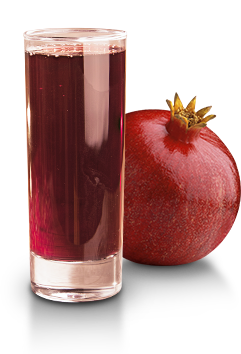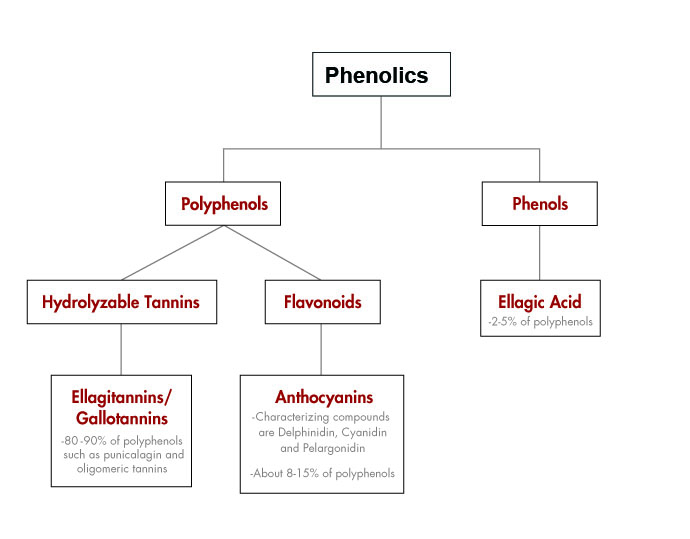
Explore Scientific Studies on Wonderful Variety Pomegranates
There are several varieties of pomegranate grown in various locations throughout the world. The following research was conducted exclusively with California-grown, Wonderful variety pomegranates.
Glossary
Anthocyanins
Naturally occurring polyphenolic compounds give many fruits, vegetables and plants their bright colors. Originally derived from two Greek words meaning plant and blue, anthocyanins are what make eggplants purple and pomegranates red. Many of the antioxidant characteristics in plants are due largely to anthocyanins. In fact, the darker, more deeply red and blue fruits usually have higher values of antioxidants; the rich, red pomegranate is absolutely loaded.
Antioxidants
Antioxidants are scavengers that may neutralize free radicals before they get a chance to harm your body. They get their name from their ability to inhibit oxidation. There are lots of different substances we call antioxidants, including many vitamins and minerals. Not all antioxidants are created equal, and some of the most powerful polyphenol antioxidants are found in great abundance in pomegranates.
Assays (Antioxidant Potency Tests)
Oxygen Radical Absorbance Capacity (ORAC)
Assay that measures the oxidative degradation of a fluorescent molecule after being mixed with free radical generators. The more antioxidant capacity you have (from the food), the less of the fluorescent molecule will degrade (and the higher the score).
Free Radical Scavenging Properties by the diphenyl-1-picrylhydrazyl (DPPH)
Assay is used to test the ability of compounds to act as free radical scavengers or hydrogen donors, and to evaluate antioxidant activity of foods.
Ferric Reducing Antioxidant Power (FRAP)
Assay works by using antioxidants as reductants in a chemical reaction. As the mixture of ferric tripyridyl triazine reduces (the more antioxidant, the greater the reduction) it turns a brilliant blue color, which can easily be measured. The greater the antioxidant activity, the bluer the mixture becomes.
Trolox Equivalent Antioxidant Capacity (TEAC)
Assay that measures antioxidant strength based on Trolox (a water-soluble vitamin E derivative having antioxidative activity – so it is the reference), measured in units called Trolox Equivalents (TE), e.g., micromolTE/100g. Due to the difficulties in measuring individual antioxidant components of a complex mixture (such as pomegranate juice), Trolox equivalency is used as a benchmark for the antioxidant capacity of such a mixture.
Ellagic Acid
A naturally occurring phenolic compound phytochemical found in many fruits and vegetables, with levels much higher in berries and pomegranates than in apples, pears or walnuts.
Free Radicals
Free radicals are atoms or molecules in the body with an unpaired electron·making them highly unstable. Because electrons normally come in pairs, the free radicals collide with other molecules in an attempt to steal an electron, and may start a chain reaction, damaging DNA and cells. Emerging science suggests this free radical damage may be linked to disease. Free radical scavengers, or antioxidants, bind with the free radicals before they can do their damage.
Oxidation
When those unstable free radicals “borrow” an electron from a normal cell in the body, the process is called oxidation. It’s the same process as when metal rusts, or a cut-up apple turns brown. Free radicals cause oxidation inside the body, which is why you want plenty of antioxidants, or compounds that inhibit chemical reactions with oxygen.
Phytochemicals
Phytochemicals is simply a word that means plant chemicals. Once, researchers attributed the health-promoting effects of plants to their numerous vitamins, minerals and fibers. More recently, however, researchers have discovered that the many other chemical compounds in plants also provide benefits to humans when consumed. Phytochemicals provide plants with protection from the environmental challenges they face, such as ultraviolet light. When we consume plants rich in phytochemicals, they seem to protect us as well. Some researchers estimate that up to 40,000 different phytochemicals will someday be fully catalogued and understood. Polyphenols are a class of phytochemicals that are particularly rich in antioxidants and plentiful in pomegranates
Polyphenols
An important class of phytochemical. And tannins, particularly punicalagin, anthocyanins and ellagic acid are all members of the polyphenol family. While many fruits contain some of these antioxidants, pomegranates have large amounts of all three.
Phenolics in 100% pomegranate juice

Pomegranate Oil
Each pomegranate contains 600–800 seeds and when purified, oil from these seeds is a rich naturally occurring source of the bioactive compound 9-cis, 11-trans conjugate linolenic acid (CLA). Since the pomegranate juice and seed oil contain different bioactive compounds, it is reasonable to speculate that they may exert different physiologic effects.
Punicalagin
A hydrolyzable tannin, punicalagin is found almost exclusively in pomegranates. This highly unique and potent polyphenol antioxidant breaks down to ellagic acid.
Tannins
Tannins are plant polyphenols that add color and a slightly tart taste to pomegranates and many other vegetables and plants. The word tannin comes from the Celtic word for oak and refers to the source of tannins used to convert animal skins into leather. In folk medicine, tannins were used to treat burns and as an astringent. While there are tannins in some teas and in red wine, tannins are truly abundant in pomegranates.
